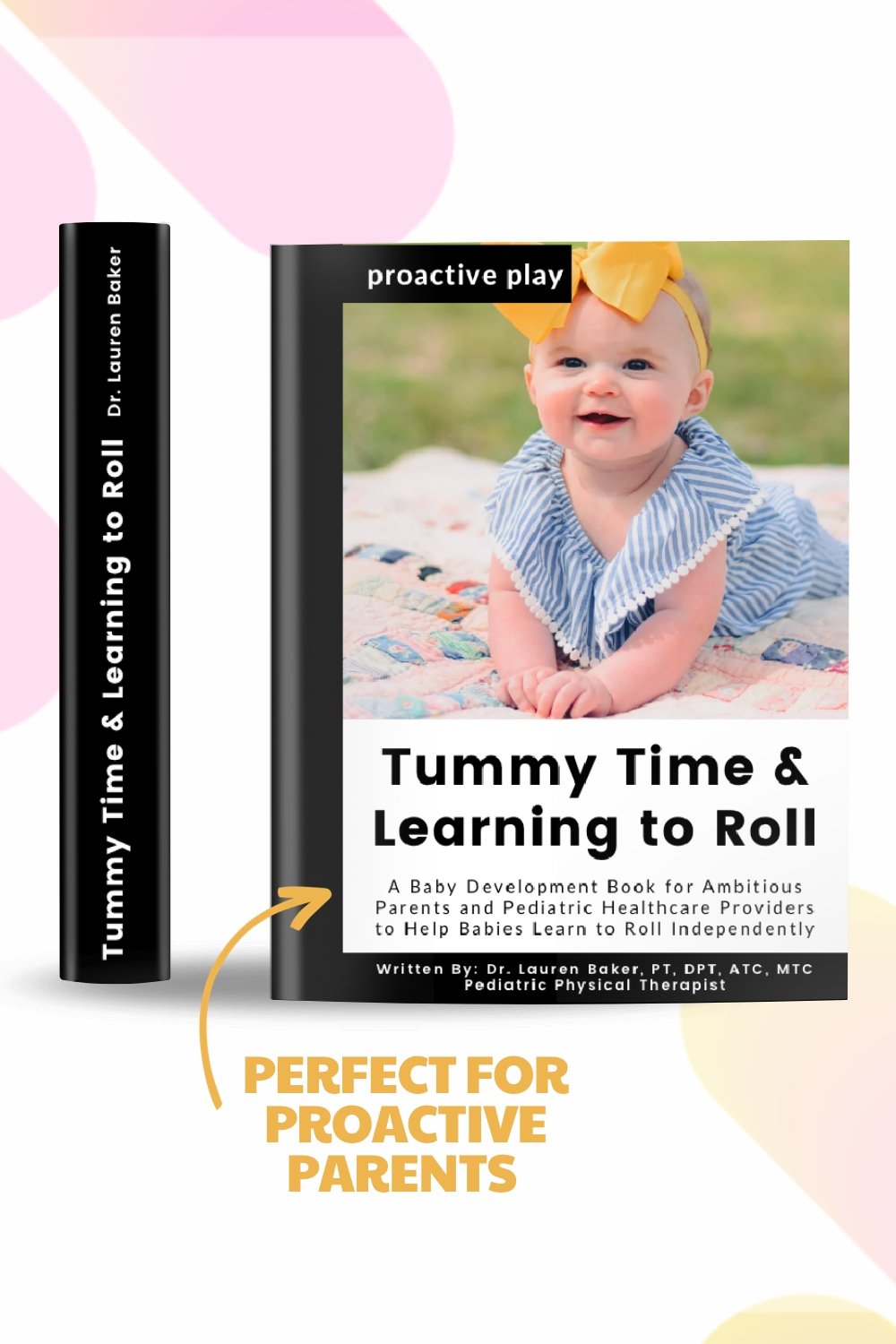Is Rolling Over A Milestone and When Do Babies Roll Over?
this blog contains affiliate links
A lot of parents are googling, “is rolling a milestone for babies?” And I am here to help you answer that question. 👋 Hi, I’m Dr. Lauren Baker, a pediatric physical therapist and I believe the more educated eyeballs we have on our babies, the better off our babies are. I do that through blogs like this on the website and youtube videos, so make sure to check out the full youtube video down below for the most comprehensive information.
The Importance of Rolling
First things first, let's address the burning question: Is rolling a milestone?
Absolutely!
Rolling from belly to back and vice versa is not just a nice-to-have skill; it's a crucial developmental milestone that signals healthy progression in your baby's physical abilities.
Here's why it's so important:
Indicates Symmetrical Development: Rolling helps us observe if the baby is developing strength and flexibility equally on both sides of the body.
Prepares for Future Milestones: Mastering rolling is essential for the next stages, such as sitting up independently and crawling. Sometimes, the impact of not rolling in all directions isn't visible until more complex skills are expected.
It might seem fine if a baby skipped rolling because it doesn’t always impact sitting on their own (but it can because rolling develops core strength, which is needed for sitting). Most of the time, babies who struggled with rolling or skipped rolling end up struggling much more with crawling than sitting.
Crawling is one of the most difficult movement milestones and it requires a lot of rotation, just like rolling. If you haven’t mastered rolling, which develops those motions, then your baby may have an underlying block that may make it more difficult to master crawling.
Encourages Exploration: It's a baby's first step towards moving independently, sparking curiosity and exploration of their surroundings.
Rolling: How Many Ways Can A Baby Do It?
Rolling involves four distinct directions:
Belly to back over the right arm
Belly to back over the left arm
Back to belly over the right arm
Back to belly over the left arm
Each direction requires different muscle movements, and if a baby struggles with any, it's crucial to understand why. This could indicate areas where your baby might need extra support or practice.
Like for example:
If a baby can roll belly to back over the right arm and Back to belly over the left arm but not in the opposite directions, they may be able to rotate their trunk to the left, but not to the right.
If a baby can roll belly to back over the left arm and Back to belly over the right arm but not in the opposite directions, they may be able to rotate their trunk to the right, but not to the left.
Baby trunk tightness is often the underlying block a baby struggles with when they struggle with rolling. You can find out more about how this fits together in my book Tummy Time and Learning to Roll, along with mobility exercises to make sure your baby can rotate in both directions equally.
Guidance from My Book: Tummy Time and Learning to Roll
To dive deeper into this subject, I've detailed everything about rolling, its significance, and practical exercises in my book, Tummy Time and Learning to Roll. It's designed to be an accessible resource for parents and pediatric healthcare providers alike. It is by far the most comprehensive resource on the topic, because it’s my entire brain on rolling, on paper + with 240+ pictures and a free online video course to put it all together.
If you notice any difficulties with rolling in your baby, the book offers checklists and step-by-step guides to support their development. Plus, you get access to that free video course and printable PDF downloads for hands-on learning and tracking progress.
CDC Milestone Updates
In 2020, the CDC updated its milestones, which stirred some confusion around rolling. I cover these changes extensively in my book, highlighting the importance of keeping a keen eye on rolling as a developmental milestone, despite these updates.
For parents information, despite what the CDC may or may not say, if you ask any PT/OT/SLP, babies should roll in all four directions by the age of six months, if they are not, there is likely an underlying reason that can be influenced by parents or healthcare providers, to assist babies in achieving their rolling milestones.
How Can You Support Your Baby's Rolling Skills?
Encourage Tummy Time: Regular tummy time from the time they are a day old strengthens neck, shoulder, and arm muscles, laying the foundation for rolling over, but hint: it’s not the ONLY play position babies need to roll (there are three others and all are listed in the book along with example photos on how parents have helped their babies play in them in their homes).
Use Toys for Motivation: Place toys slightly out of reach during tummy time to encourage your baby to stretch, reach, and eventually roll towards them. Make sure to place toys first in front, but then to the side. Toys at eye level will also help babies lift their arms to shoulder level, further prompting weight shifting and building muscles and experiences that help with rolling.
Be Patient and Supportive: Every baby develops within a range (4-6 months). Provide encouragement and gentle assistance, but allow them to achieve milestones, if they are older than 6 months, it is recommended to reach out to a Pediatric Physical Therapist for assistance.
Monitor All Directions: Keep an eye on your baby's progress in all four directions of rolling. If you notice any delays or asymmetries, consult a healthcare provider for personalized advice.
Curious About Learning More on Tummy Time, Rolling, or Both?
The absolute best book for parents on tummy time and rolling is: Tummy Time and Learning to Roll: A Baby Development Book for Ambitious Parents and Pediatric Healthcare Providers to Help Babies Learn to Roll Independently. The book comes with a free online video course to help parents fully understand how to complete the different exercises, printable checklists to know exactly where your baby is at, and when to reach out for additional help.
This book was written by Dr. Lauren Baker, PT, DPT, ATC, MTC, who is a Pediatric Physical Therapist in Boise, Idaho, trained in helping parents learn how to help their babies move and master their milestones. She loves teaching parents how to see how their babies are moving as well as how to influence those movements though play positions and exercises to help babies move with confidence and ease.
Tummy Time and Learning to Roll is the first book in the Proactive Play series written by Pediatric Physical Therapist Dr. Lauren Baker in order to help Ambitious Parents and Pediatric Healthcare Providers learn how to help babies master tummy time and learn to roll. It is meant to help ambitious parents understand baby development from birth to six months (tummy time to rolling).
This book is a mix of easy-to-follow and more in-depth information than is typically found in baby development books because Dr. Baker believes parents deserve to have all the information at their fingertips.
This book breaks down each piece of movement in checklists so that parents know what their babies need for tummy time and rolling. It also covers what areas might limit a child with rolling, why it is so important, and when to seek help from a pediatric PT.
This book comes with colored photos and easy-to-follow demonstration videos that can help parents implement safe, strategic play-based exercises with their babies in 20 minutes per day.
A Great Resource For:
Parents and Pediatric Healthcare Providers of babies 0-6 months
Parents of babies who are struggling with tummy time, rolling back to belly, belly to back, or only to one side
Access to simple, easy-to-follow videos of play positions and exercises
Learning the four pillars of movement needed in order to master rolling
240+ Color Photo Examples of:
Tummy Time, Sidelying, and Back Play
Developmental Toys and Equipment
Hand Placement and Strategic Play Positions
Common Areas of Restriction or Weakness
When To Reach Out For Help
What If You Want Extra Help?
If you have concerns about their movement, remember, you can always reach out to a pediatric physical therapist. It's your right as a parent to advocate for your child's development.
Sometimes, a few tips and tricks are all you need to get your baby moving better. We're here to support you and release those mama worries. If you are looking for in home pediatric physical therapy, check our listing of therapists.
For those eager to learn more or seeking personalized guidance, I offer online video parent consultations internationally which can be scheduled by clicking here. I am dedicated to answering questions and providing tailored play activities for each unique developmental journey.
When Should Babies Receive Pediatric Physical Therapy?
Parents can call and schedule with a Pediatric Physical Therapist at any time, for any concern in all fifty states without a referral from their Pediatrician.
Pediatric Physical Therapy is medically indicated in all babies who are not rolling in all four directions by six months (back to belly over their right arm AND left arm + belly to back over their right arm AND left arm).
Pediatric Physical Therapy is medically indicated if you notice a flat spot on the back of an infants head (possible plagiocephaly), a tilt of their head consistently to one side (ear to shoulder - possible torticollis), or a rotation preference of their neck (consistently look only to the right or left - possible torticollis).
Many Pediatric Physical Therapists including Dr. Baker, can successfully treat flat spots (Plagiocephaly) without a helmet with a combination of therapy and positioning strategies if seen prior to 4 months (0-3 months is ideal). Dr. Baker uses the Baby Begin Method of repositioning.
Flat spots can be due to in-utero positioning, rotational preference (right sided flatness most common) and babies are at an increased risk for flatness if they are male, were breech, multiple birth, premature, have difficulty with tummy time, or are in containers > 2 hr/day.
Final Thoughts: Let's Stay Connected
I'm passionate about empowering parents with the knowledge and tools to support their children's development. If you've used the book and found it helpful, I'd love it if you could write a review, they help self-published authors like myself SO MUCH and I love reading them all! PS not sure where reviews are located? Go to your amazon account —> orders —> write a product review button (white button on the bottom!).
Drop your questions in the comments of the video linked above or share your experiences via DM on instagram @drlaurenbaker. Your feedback not only enriches our community but also supports the mission of making developmental information widely accessible.
Remember, you're not alone on this journey. Together, we can ensure our little ones have the strong, healthy start they deserve. Until next time, keep connecting with your babies through proactive play.








